
It’s all Lon’s Fault! A few years ago, I used to go Lon’s office to say “hi” and he had the coolest metal dice in his office! Steel Dice! Aluminum Dice! Titanium Dice (maybe?)! Every time I see metal dice, I think of Lon. Hi Lon!
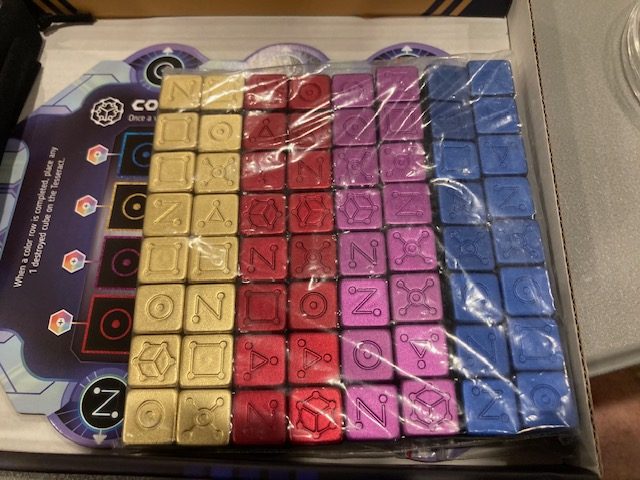
Well, when Tesseract (A cooperative dice-placement/cube manipulation game) came onto Kickstarter, I was enthralled! And it’s all Lon’s fault! The Metal Dice (see above) looked so cool! It was so cool looking that the #1 spot on my Top 10 Anticipated Cooperative Games of 2023!
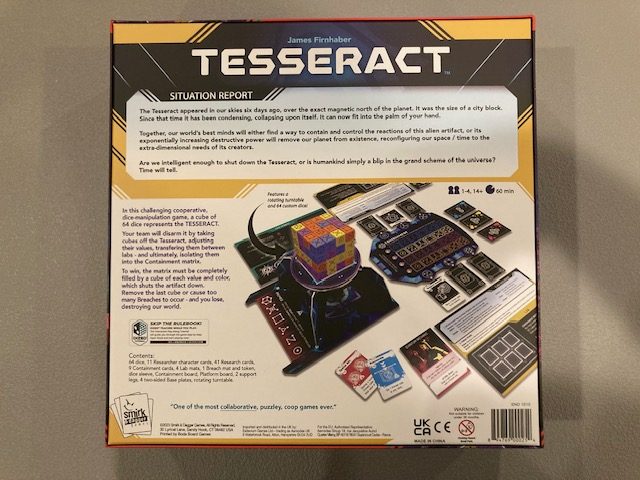
This cooperative game, Tesseract (plays 1-4 players in 90 minutes) arrived at my house in mid-September, 2023. It was on Kickstarter back in November 2022, but unfortunately promised delivery in July 2023. Ah well, the streak of Kickstarters delivering early or on time has now been broken: Tesseract was about 3 months late (to me: I think other Kickstarter backers in the rest of the world got it earlier).

I got the base game and the metal dice upgrade: Again, it’s all Lon’s fault!
Unboxing
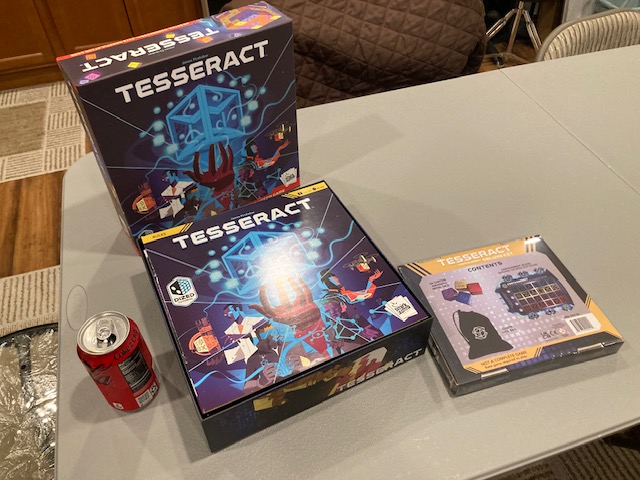
This is a pretty standard sized box, with the oversized rulebook that fits flush with the box: see my can of Coke above for perspective.

There’s a number of punchouts for building the cube-holder.
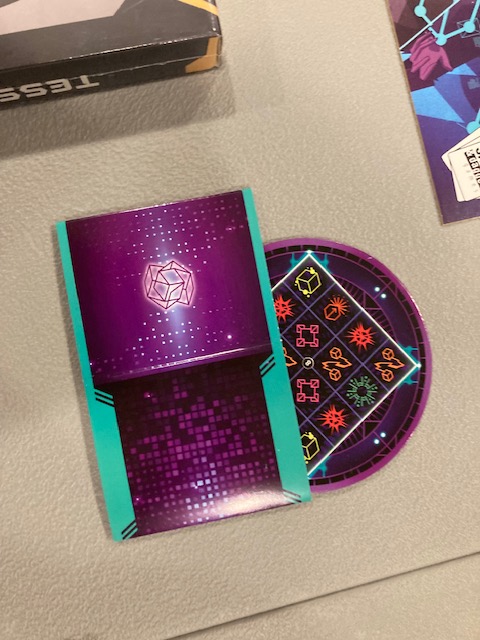
There’s a sleeve that looks a little like a “Hot-Pocket” sleeve. (This maybe an American thing only? If you don’t know what “Hot Pockets” are, I encourage you to look them up: Jim Gaffagan you tube videos may be the funniest source of info). These sleeves will be used for guiding the dice (see more pictures/discussion below).

The base game comes with 64 plastic dice that are well-labelled and easy to read.

Maybe Lazy Susans are cool now? The game comes with a Lazy Susan for “spinning” the dice cube. (Planet Unknown was very popular last year and everyone raved about the Lazy Susan with that game). We’ll see more how this works in the gameplay.

There’s a number of giant Mats: breach, player sheets, and something else.
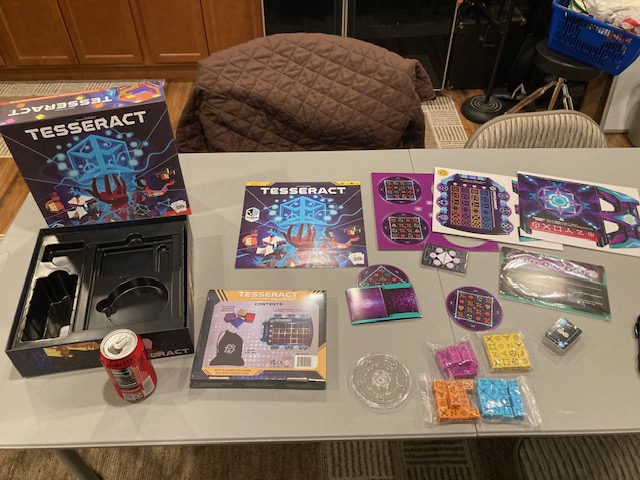
The game looks pretty snazzy! “But what about the metal dice, Rich???” Hold on! Hold On! We’ll get to those after a look/play with the base game. Look, as cool as the metal dice are, they are expensive, and they don’t come with the base game.
Rulebook

The rulebook seemed pretty good overall. Unfortunately, it gets like a C+ on the Chair Test: it’s huge and flops all over the place:

Despite that, the rulebook does a pretty good job of showing set-up and taking you through the components, set-up and the core rules.
Set-Up

The first part of set-up was building the Lazy Susan holder. The Tesseract, the 4x4x4 cube of dice, lays atop the Lazy Susan. See above with a nice perspective on how the dice fit.

The little Lazy Susan has 5 ball-bearings so it can rotate easily.

You put on on these circular cardboard pieces atop the Lazy Susan. When a column completes, each symbol activates a bad news in the game.
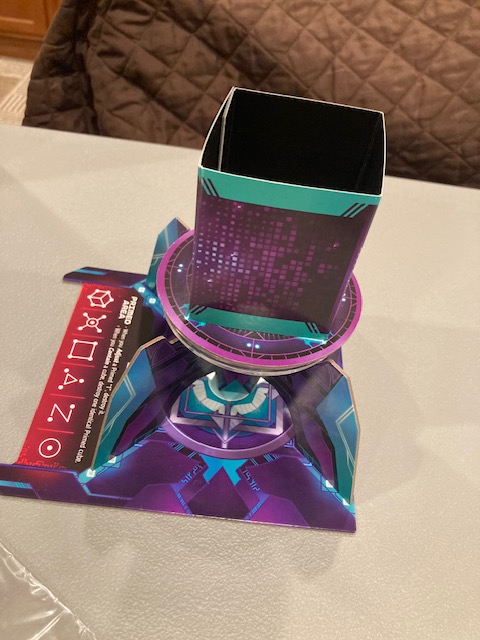
The Lazy Susan and bad new circle sit atop a little mechanism to keep it aloof. The little dice sleeve (the “Hot Pocket” sleeve we saw earlier) opens up so it can guide the dice down during set-up.

Then you start pouring dice into the little stand!
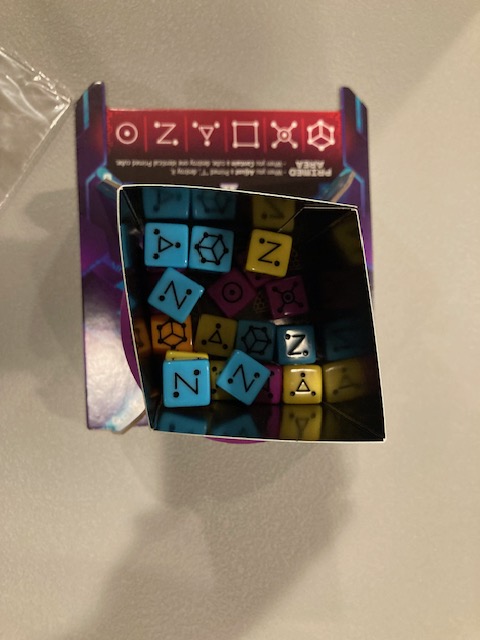
It’s a little wonky to get the dice in there at first: see above. You have to make sure the dice fill the 4x4x4 template perfectly.

Once you get all the dice in there … you slowly remove the sleeve … to reveal …
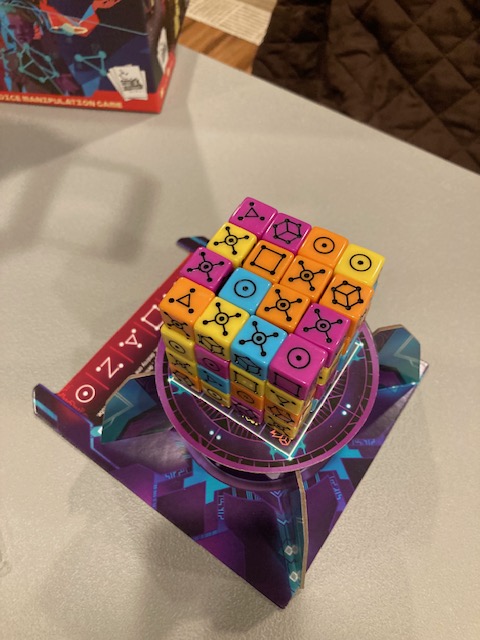
A stunning cube of dice!

The rest of the set-up is much less interesting, but the rulebook describes it pretty well.
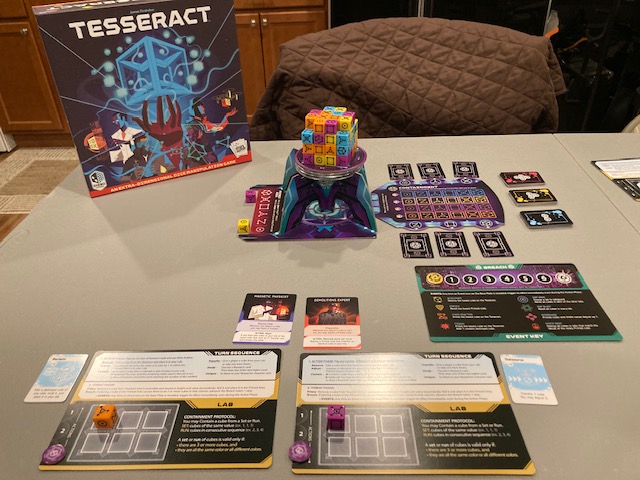
All set-up: the game looks pretty cool!
Gameplay
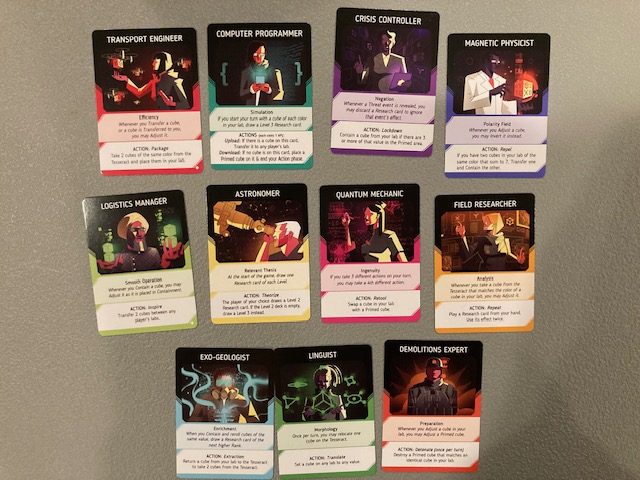
Each player chooses a special role at the start of the game: each of these give special powers (both active and passive) for manipulating the cubes and other parts of the game. Players gets asymetric powers.
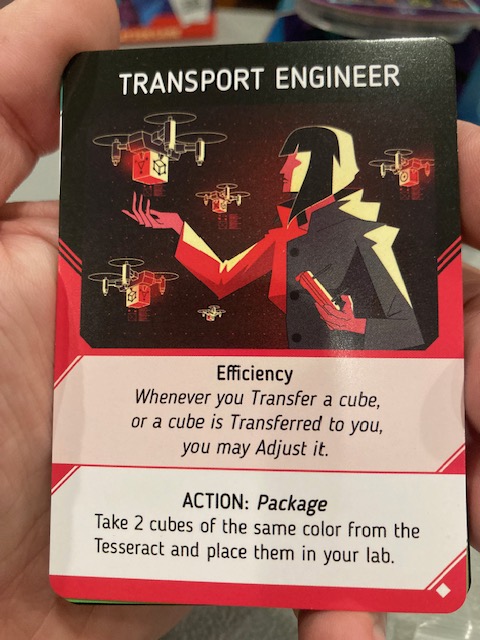
For example, the Transfer Engineer above has a passive special ability (Efficiency) which allows dice manipulation. The ACTION is a special action only the Transport Engineer can take on their turn. Every player gets three ACTIONs on their turn.
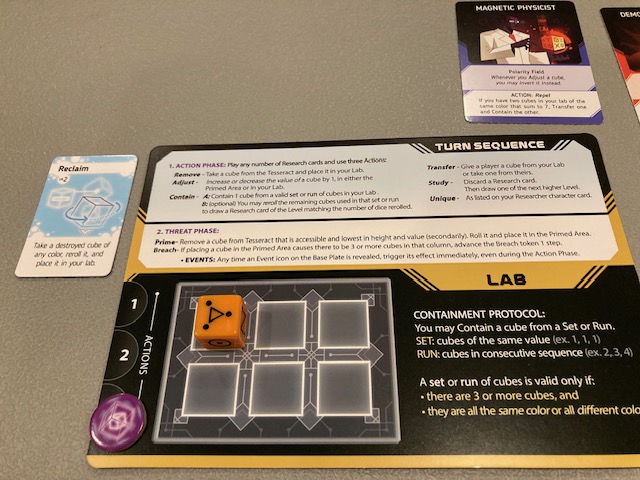
The Turn Sequence is noted on each players player sheet (each player gets one). This game is all about manipulating dice, so every player has a “lab” that contain 6 dice to manipulate.

How do you win? If you can get 24 of the dice into containment (4 rows with 1-6 on them), the players win! As the game flows, dice slowly come of the cube, both as good news and bad news.

If the cube is ever empty, players lose!

Every turn, one die will come off the cube during the Bad News phase: it gets re-rolled and placed in the appropriate space of the primed area. If there are ever three dice in a single zone, the breaches chart goes up 1! This feels slightly like a Pandemic element, as you have to keep the primed area under control (like the map in Pandemic).

If you ever get 7 breaches, players also lose!
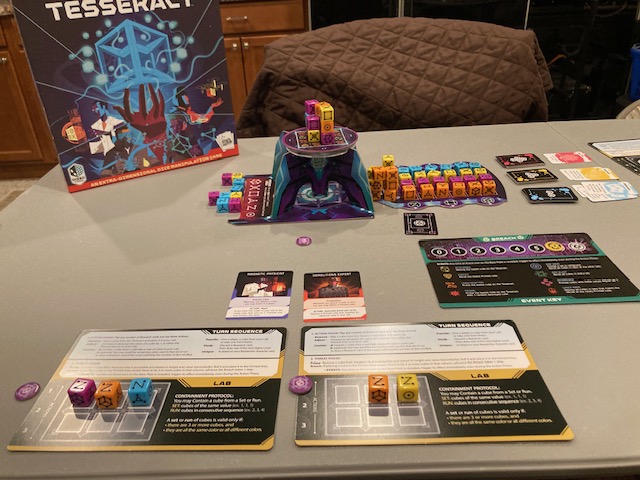
The majority of the game is trying to keep the Primed Area under control, while slowly containing dice, and watching as the Tesseract gets smaller and smaller! The ACTIONS you perform all have some effect on that.
Solo Play

There is a nice sentence above step 6 describing solo play :”In a one-player game, set up two Labs, each with a Researcher. You will alternate between both Researchers.” Huzzah! That’s all it takes! Congratulations to giving us a simple solo game (and following Saunders’ Law)! No special exceptions!
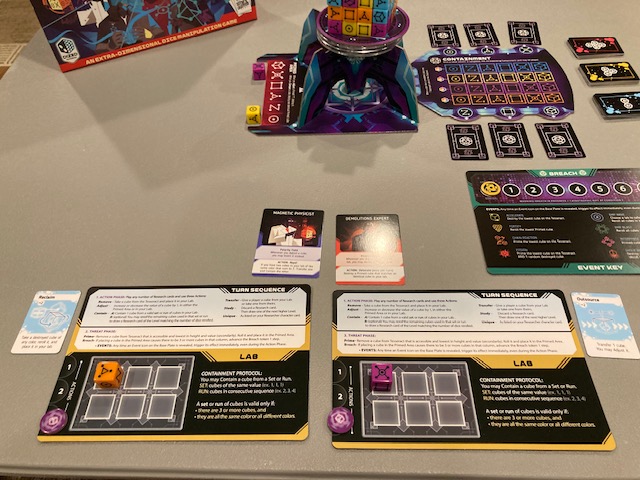
See above as I have a solo game getting ready to go! It was pretty easy alternating between the two Researchers. The Researchers are very consistent in specials: they both have a special Action and a special passive power. You are pretty sure those specials will be the difference between winning and losing, so it wasn’t too hard to switch between them and remembering to use the powers.
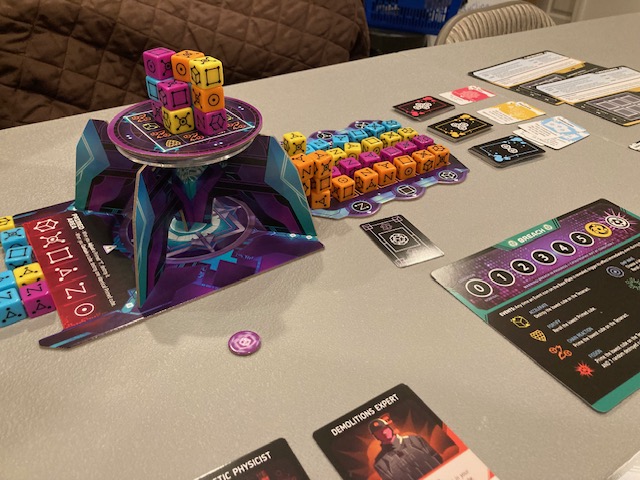
I was learn to play a solo game pretty easily. It was fun! There would be no problem teaching my friends, as the solo game scales perfectly well and up to 2-4 players.
Cooperative Play
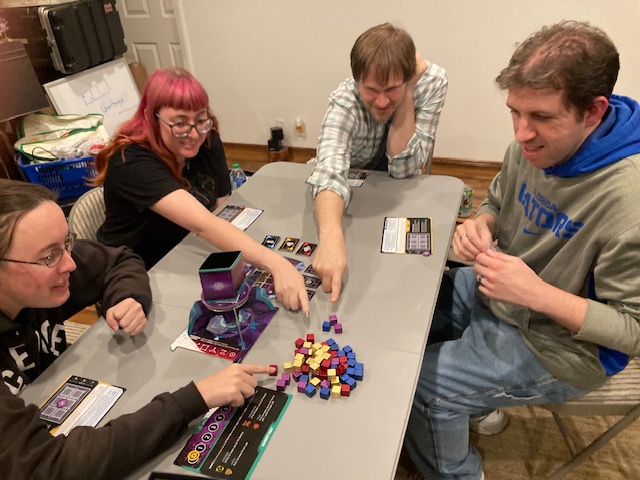
I asked my friends which dice they liked better: metal or plastic. Overwhelmingly Metal Dice! So, that’s what we play with from now on.

Interestingly, people seemed to stand up around the table to play cooperatively! Part of that was to get a good perspective on the Tesseract!
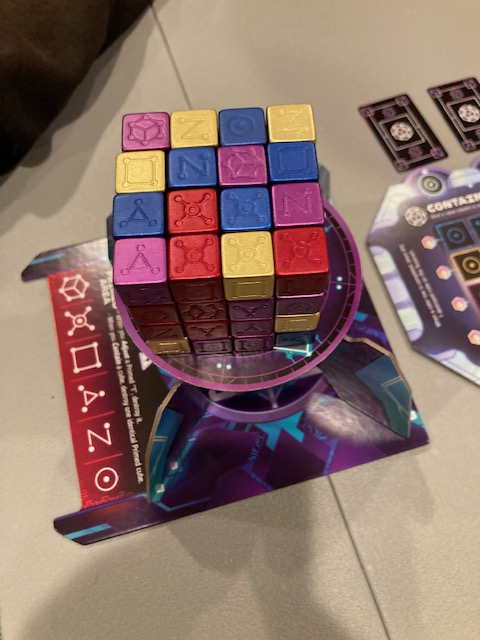
The game seemed to scale well, and there were a lot of cooperative mechanisms and powers in the game. The sharing/trading aspect of dice was a real interesting dynamic! Sure, you can always take a die you need from the Tesseract, but if you do that too quickly, the Tesseract depletes and you lose! So, the players tend to share/trade dice more than I expected in the game. There was a good amount of cooperation and talk!
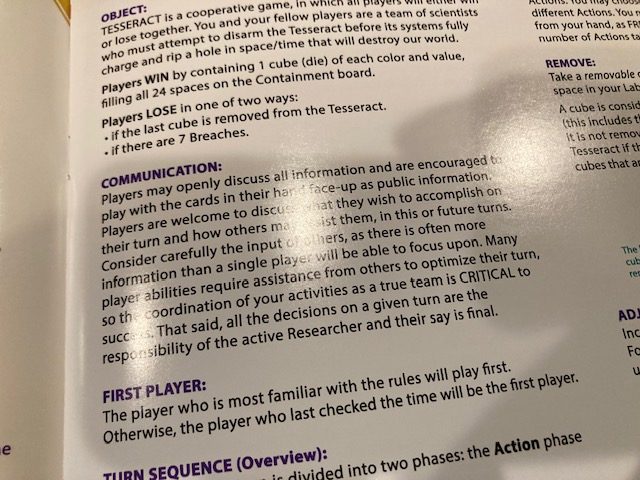
One of the things I really like about Tesseract is the game encourages players to share and talk as much as possible! There’s an entire paragraph in the rulebook (see above) to that end! Now, I like “limited communication” co-op games, but I get tired of the “limited communication”, because I want to sit down (or stand up in this case) with my friends and interact/talk/have fun! So, I think the cooperation works really well here.
Dexterity Game

The rulebook says clearly “this is not a dexterity game”, and yet, it felt like it, a little. You have to carefully pull the appropriate dice off the Tesseract without spilling it over. Now, we never did, but Andrew leaned on the table at one point and it almost caused a catastrophe of fallen cubes! So, it’s not a Dexterity game, but the cube tower is a little more precarious than it looks. Make sure you set-up on a stable, flat surface to avoid any issues! One bad lean will kind of ruin the whole game.
Metal vs Plastic Dice

The Plastic Dice that come with the game are perfectly serviceable and they look fine and work fine. In fact, we think the plastic dice are probably a little easier to read.
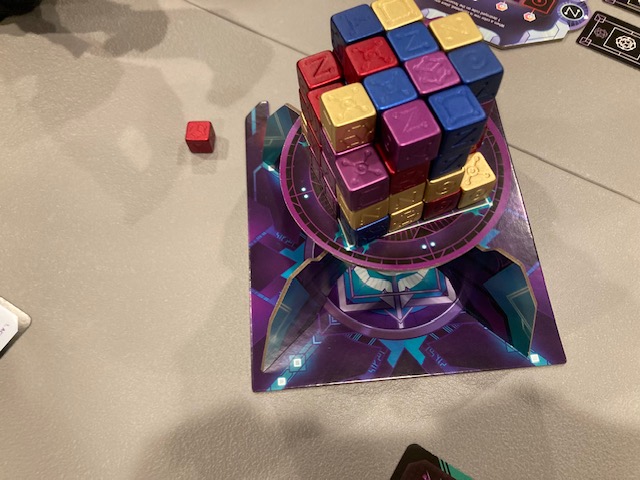
But it’s clear the metal dice were the favorite. They feel “more spacey” and more like what a Tesseract would be made of! But, they are an add-on, and they are expensive. Like significantly: the base game was $50 on the Kickstarter, and the metal dice + game was $130! So, an $80 difference (and the Kickstarter calls them a $128 value so maybe more in retail).

The game works fine with Plastic Dice. If you aren’t sold on the Metal Dice, try the base game with plain dice. You can probably buy the metal dice later if you really like the game.
Cube Games

Those of you paying attention might remember we reviewed another cooperative Cube Manipulation game last year: Minecraft: Portal Dash! (See our review here). And it surprised us how much we liked it! It made our Top 10 Cooperative Games of 2022! It almost feels like this should be its own category of game now … Cube Manipulation? There are a surprising number of similarities between the games, as the Tesseract, err Cube, is both the good news and bad news of both games! They’re different games: I think Tesseract is tighter and more streamlined, but Portal Dash has a certain charm to it as well! If you like one, you may well like the other.
Toy Factor

There’s a large amount of toy factor in the game: the Lazy Susan, the aloft dice cube, the metal dice. And I think it works! It makes the game attractive and more interesting to play! However, there is a good game underneath as well. Unfortunately, the Lazy Susan wasn’t “quite as cool” as I hoped, as it seemed to be a little precarious. It sill worked overall, but it still felt “a little” like a Dexterity Game .. more than it should. I do think that’s a minor complaint, but just one to be aware off.
Game

There’s a good game here. There’s some mechanisms that don’t make sense at first (“Why would I want to reroll my dice to get cards?”) until you’ve gotten into the game. There are plenty of interesting ideas here to keep players engaged! Occasionally, it felt like there was maybe one too many rules (For example: You can destroy a dice in the primed area if you contained the same dice in the Containment area: we forgot this rule a number of times, but at least it’s notated on the Primed Area) and we have to remind ourselves of those, but that’s great in a cooperative game! That is one advantage of cooperative game: players can work together to remember those rules! Arguably, that contributes to the cooperation in the game.
Conclusion

Tesseract is a really great game. Me and my game groups loved the toy factor, the metal dice, the gameplay, and the overall feel of this game! The game underneath the toys is also quite good! It had a little bit of Pandemic vibe in a few places, but there were enough new and interesting mechanisms to note that this is not some kind of Pandemic clone. In fact, between Tesseract and Minecraft: Portal Dash, it may be we are seeing a new type of game: Cube Manipulation!
This will easily make my Top 10 Cooperative Games of 2023. It was #1 on my Top 10 Anticipated Cooperative Games of 2023 for a reason! But, we all know it’s Lon’s Fault!!
(For the record: I bought this game and all extras with my own money. We never accept free copies of any games nor take any money/incentives from any publisher or anyone. This is and has always been our policy at CO-OP Gestalt, but we thought we needed to say it more often. You may hate our opinions, but at least you are sure they are our own).
Looks great! Love the toy factor. This and Menara would be great games for Nukestock game nights. Light, funny, and fun!
LikeLike
Remind me to bring them!
LikeLike